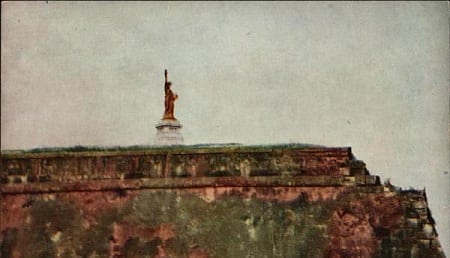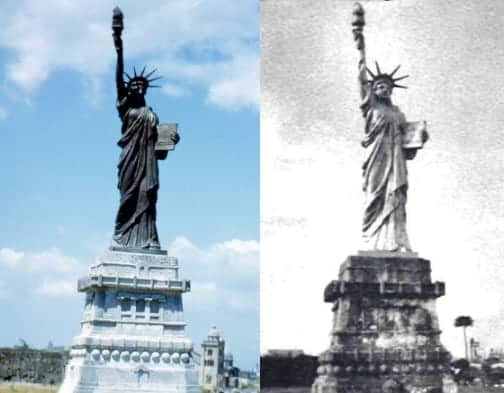Whatever Happened To Manila’s Statue of Liberty?

Not many people today remember that a Statue of Liberty–just like in New York–used to be a landmark in Manila. This replica, however, was not your ordinary imitation; it was a gift to the Philippines from the United States just as the original statue was a gift to the United States from France.
Also Read: 29 Things You’ll Never See in Manila Again
The eight-foot Statue of Liberty used to stand in Baluarte de San Diego in Intramuros but reportedly disappeared in the early 1970s. This article explores its whereabouts, its fascinating history, and what it symbolizes in the context of Philippine-United States relations.
Statue of Liberty: A Brief History
Since its inauguration in 1886, the now-iconic statue, formally known as Liberty Enlightening the World, has become a symbol of freedom, the United States, and its close ties with France.
After all, it was a gift to the Americans from the French who helped the former achieve freedom from the British in 1776.
The 225-ton and 305-foot monument was designed by Frederic-Auguste Bartholdi, a French sculptor. It is said that Lady Liberty was modeled after Bartholdi’s mother, Charlotte, and it took him 10 years to complete the monument.
Alexandre-Gustav Eiffel, a French engineer of Eiffel Tower fame, helped Bartholdi in the construction by suggesting the use of copper and building a steel frame for the monument.
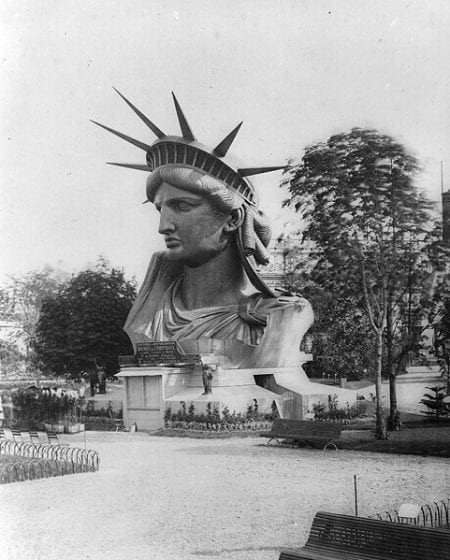
Building the Lady Liberty was quite an expensive endeavor for France, and it was the lack of funds that delayed its construction. Fortunately, the cost was covered through donations, a French lottery, and a benefit concert at the Paris Opera, among others.
As for the statue’s base and pedestal, America was able to defray the expenses through Joseph Pulitzer, a newspaper magnate who used his New York World to raise awareness and ultimately earn donations to complete the project.
Related Article: 7 Most Unintentionally Terrifying Statues In The Philippines
The monument was installed in Bedloe Island (now Liberty Island) in the New York harbor. It not only serves as a national icon but also as a gateway that welcomes millions of immigrants who come to America with hopes of a better future.
A Gift of Liberty
As early as January 1945, there was already news of a campaign that would help erect a Statue of Liberty replica in the Philippines. The said monument was supposed to be sponsored by The Chicago Daily Times whose goal was “to commemorate one of the great epics in the struggle for human freedom–the liberation of the Philippines.”
Fast forward to 1950, the Boy Scouts of America was celebrating its 40th anniversary. Jack P. Whitaker, then Scout Commissioner of the Kansas City Area Council had earlier suggested the creation and distribution of several Statue of Liberty replicas to all American states and territories, including the Philippines.
The eight-foot statues, which were cast in bronze, were distributed all over the U.S. and the world from 1949 to 1951. Almost 200 replicas were delivered to the 39 states of the U.S. and countries such as Panama and Puerto Rico.
The Boy Scouts of the Philippines, on the other hand, received its own replica in the early part of 1950.
The statues were donated by the Boy Scouts of America as “an expression of scout brotherhood and goodwill.” Not surprisingly, their 40th-anniversary theme was “Strengthen the Arm of Liberty.”
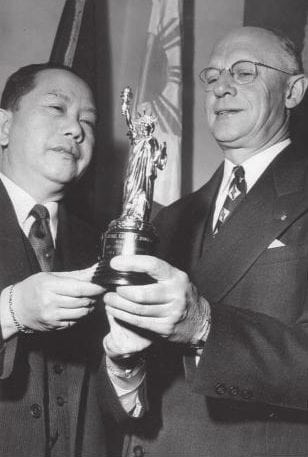
Miniature versions of the statue were also given as gifts. In fact, the Philippines became the first independent nation to receive one of the 4,000 eight-inch statues from the Boy Scouts of America.
In April 1950, the said statue was officially given by Chief Scout Executive Arthur A. Shuck to Carlos P. Romulo, then chief of the Philippine Mission to the United Nations.
In the Philippines, several places were shortlisted to become the site where the eight-foot bronze replica would be erected. The task of choosing the perfect site was delegated to the National Urban Planning Commission, and among those it considered were “Engineer Island, atop the proposed reviewing stand on the Luneta, and on the center island rotunda between the Legislative building and City Hall.”
In the end, the Boy Scouts of the Philippines (BSP) erected the statue just outside Intramuros.
As the icon of the United States, the replica of Lady Liberty would survive several attacks by student protesters in the 1960s. It remained standing until the early 1970s when the BSP decided to transfer it to the Scout Reservation in Mt. Makiling which would serve as the statue’s home for two decades or so.
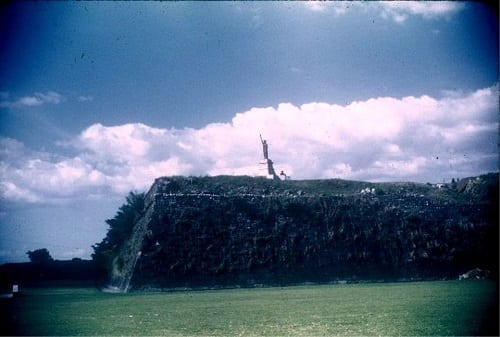
In a 2002 article published by the Philippine Star, then BSP PR head Nixon Canlapan revealed that the Statue of Liberty was eventually moved and stored at the BSP headquarters on Concepcion Street (now Natividad Almeda-Lopez) in Ermita, Manila.
Philippines’ Other Liberties
Unbeknownst to many, the American-sponsored replica was not the first Lady Liberty in Manila.
In the 1930s, one of Manila’s biggest shopping stores at that time became the talk of the town not just for its products but also for its unique multi-story building. Located in Juan Luna Street, the L.R. Aguinaldo’s Emporium had an Art Deco facade featuring two contrasting statues: Andres Bonifacio on the right and the Statue of Liberty on the left.
Also Read: 20 Beautiful Old Manila Buildings That No Longer Exist
Established by Philippine retailing pioneer Leopoldo R. Aguinaldo, the store would later become known as the Aguinaldo’s Department Store. After the war, Leopoldo’s son Francisco took over the business and the store was moved to Echague.
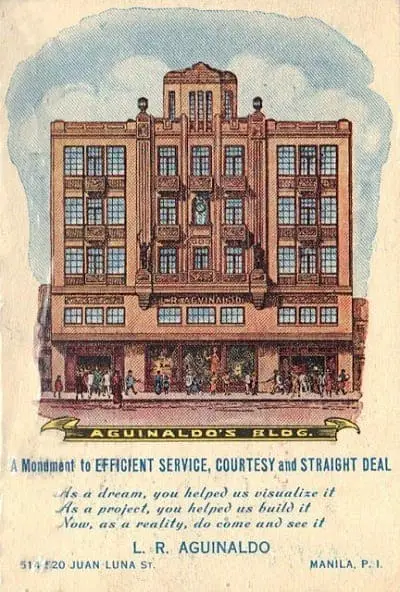
The Echague branch in the 1950s was known for introducing its customers to quality products both from the Philippines and abroad. It also commissioned young interior designers to update the store’s furniture section.
Thus, the store catapulted the careers of famous designers like Myra Cruz, Edgar Ramirez, and Bonnie Ramos, among others.
Recommended Article: 14 Beloved Pinoy Products That Are No Longer Available
Aguinaldo’s succumbed to the competition and closed in the 1960s. The original building in Juan Luna Street still stands, along with both the Bonifacio and the Liberty statues.
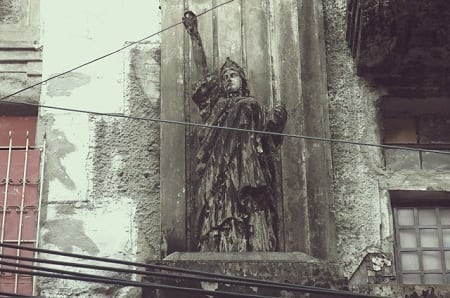
Since the creation of the Liberty statues in Intramuros and Juan Luna Street, other Philippine provinces soon followed suit. You can now find Statue of Liberty replicas in Pangasinan and as far as Camp John Hay in Baguio City.
It’s also worth noting that the replicas now serve a purpose not too far from their original intention: to serve as a reminder that American influence is here to stay and will continue to be part of Filipinos’ daily way of life.
References
Alcazaren, P. (2002). Homecoming landmarks. philSTAR.com. Retrieved 13 July 2015, from http://goo.gl/E0t1wD
Alcazaren, P. (2002). Lost Liberties. philSTAR.com. Retrieved 13 July 2015, from http://goo.gl/557uto
James, R. (2009). A Brief History of the Statue of Liberty. TIME.com. Retrieved 13 July 2015, from http://goo.gl/StFvQA
Nadal, K. (2015). Filipinos in New York City (p. 33). Arcadia Publishing.
Official Gazette of the Republic of the Philippines,. President’s Month in Review: March 1950. Retrieved 13 July 2015, from http://goo.gl/E7fBq4
Spokane Daily Chronicle,. (1945). Philippine Island Statue Is Sought. Retrieved from https://goo.gl/NvOZ6u
FilipiKnow
FilipiKnow strives to ensure each article published on this website is as accurate and reliable as possible. We invite you, our reader, to take part in our mission to provide free, high-quality information for every Juan. If you think this article needs improvement, or if you have suggestions on how we can better achieve our goals, let us know by sending a message to admin at filipiknow dot net
Copyright Notice
All materials contained on this site are protected by the Republic of the Philippines copyright law and may not be reproduced, distributed, transmitted, displayed, published, or broadcast without the prior written permission of filipiknow.net or in the case of third party materials, the owner of that content. You may not alter or remove any trademark, copyright, or other notice from copies of the content. Be warned that we have already reported and helped terminate several websites and YouTube channels for blatantly stealing our content. If you wish to use filipiknow.net content for commercial purposes, such as for content syndication, etc., please contact us at legal(at)filipiknow(dot)net

